As the investors that told you Wolfspeed (WOLF) was headed for bankruptcy long before anyone was thinking that was a possibility, we thought it only right to now report on the emergence of Wolfspeed from said bankruptcy.
Breaking down WOLF stock’s big day
On Monday September 29, 2025, the “old” Wolfspeed shares were cancelled. “New” Wolfspeed stock (under the same ticker symbol WOLF) were issued to existing shareholders. The stock price seemed to rocket more than 1,000% higher. However, that’s a result of the conversion to new stock, and it’s helpful to consider the old WOLF stock’s market cap prior to Sept. 29 ($1.21 per share on Friday Sept. 26, 2025, or a market cap of just under $190 million).
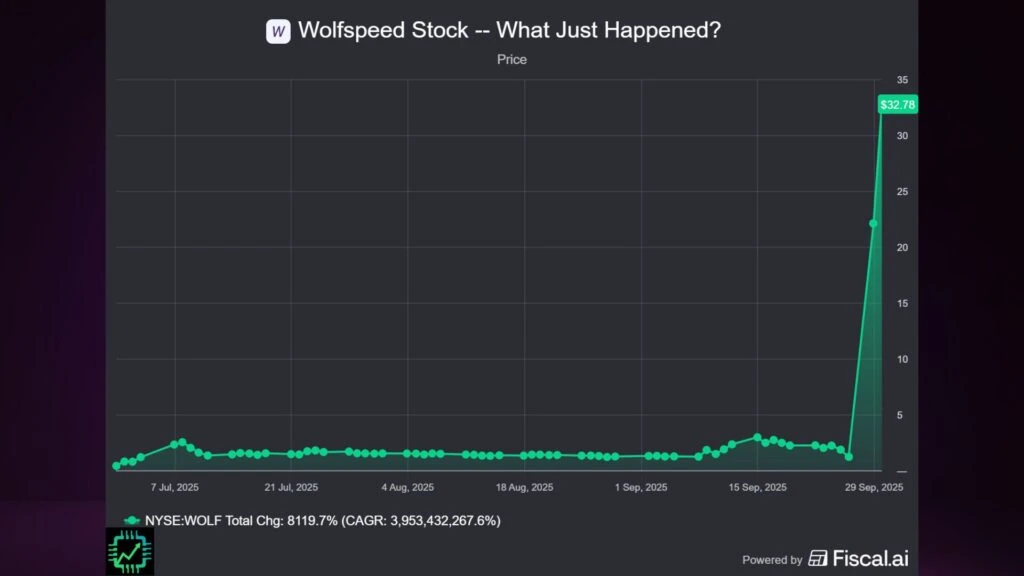
Want to make great financial visuals? Need a complete business analysis platform for your investing journey? Visit Fiscal.ai/csi, and get 15% any paid plan!
Remember, the reason for the old WOLF stock trading for such a paltry sum, even though Wolfspeed was going to emerge from bankruptcy as an operating business, was the expected massive dilution of existing ordinary shareholders, as pre-announced a few months ago in June 2025.
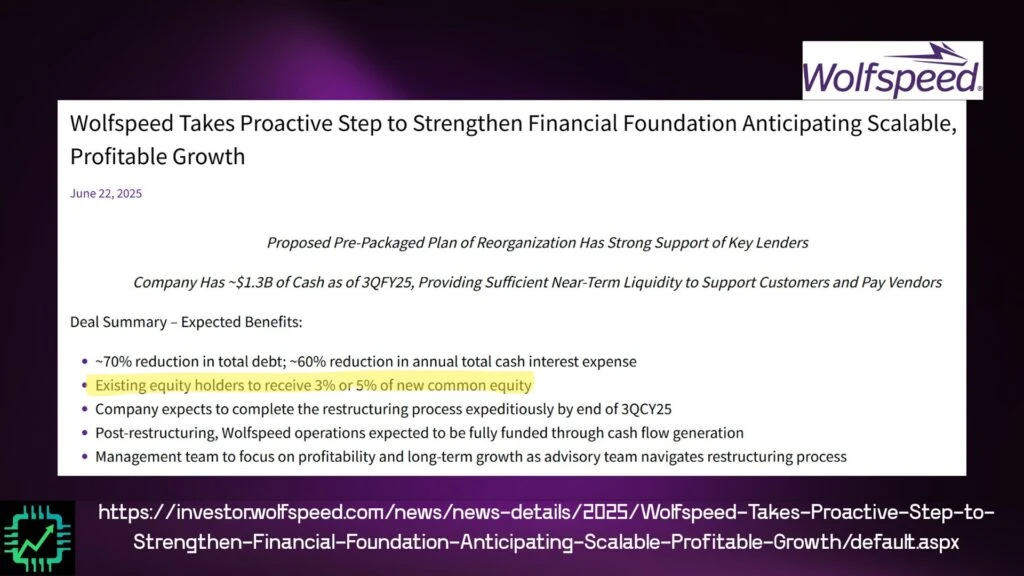
And so, to understand what happened, we need an understanding of the new WOLF stock. Old shares were cancelled, and new stock issued to shareholders on Sept. 29. The exchange rate was 0.0084 (per this SEC filing: https://d18rn0p25nwr6d.cloudfront.net/CIK-0000895419/4d7b2379-2ca6-448b-87af-4168d69b8b65.pdf). In other words, for every 1 share of old WOLF stock, you received 0.0084 shares of new WOLF stock (8.4 new shares for every 1,000 owned prior).
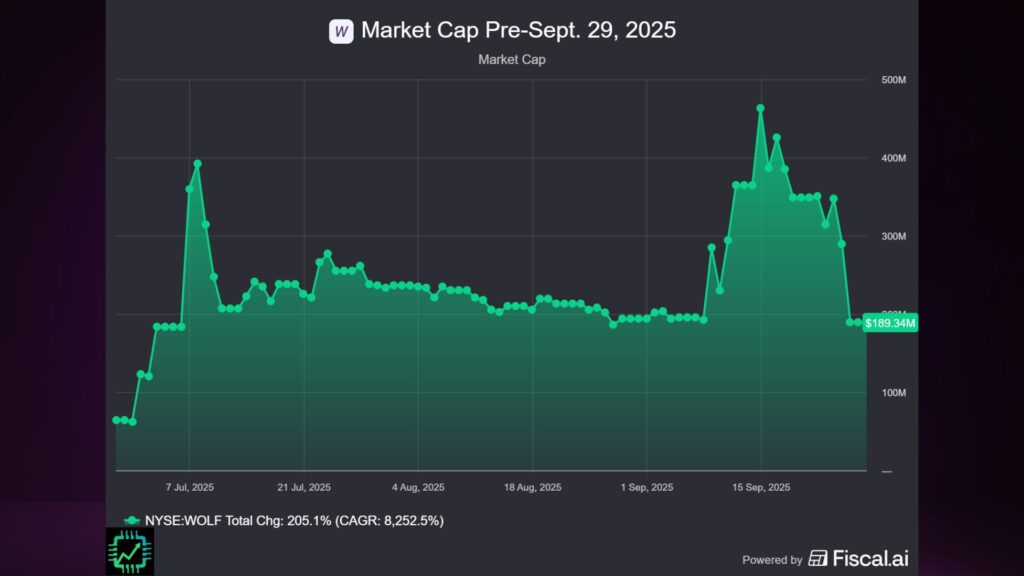
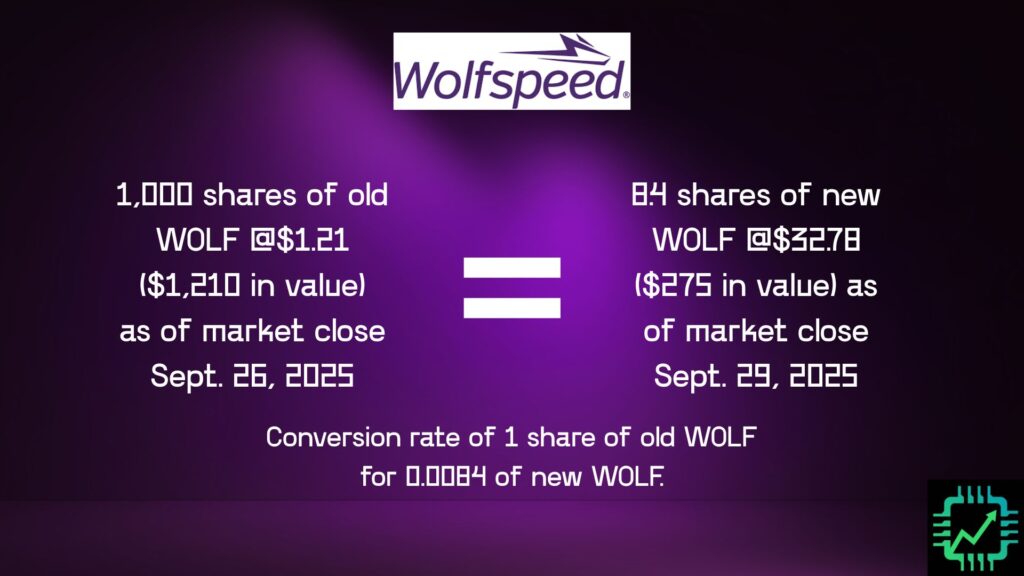
Additionally, if certain regulatory milestones are met, WOLF shareholders will receive another small batch of stock issued to them in the coming months.
We can also calculate the Sept. 29 daily jump in stock value via market cap. Given the expectation of an at least 95% dilutive event for the old stock, the $190 million market cap on market close Sept. 26, 2025, was actually representative of an expected new WOLF stock market cap of $3.8 billion ($190 million / 0.05).
Thus, while the big jump in stock price looks like old WOLF stock owners got a bailout, it was not. The rise in value was actually along similar lines to the wild fluctuations in value over the last three months during the bankruptcy proceedings.
Who else got the new WOLF stock?
Ok, so old WOLF shareholders were massively diluted. Who received the bulk of the new WOLF stock if it wasn’t the existing shareholders? The holders of Wolfspeed’s ample amounts of debt (remember, owners of a bond are ahead of equity owners in line to get repaid if a business goes bankrupt). The primary owners of that debt are private equity giant Apollo Global Management (APO) and Japan’s IDM Renesas Electronics (TYO: 6723, OTC:RNECY).
As part of the bankruptcy package, Wolfspeed got approval to reduce that debt by 70% — implying remaining debt is now at ~$1.96 billion, or $6.54 billion in debt as of June 2025 minus $6.54 billion x 0.7 ($4.58 billion debt cancellation in exchange for new WOLF stock).
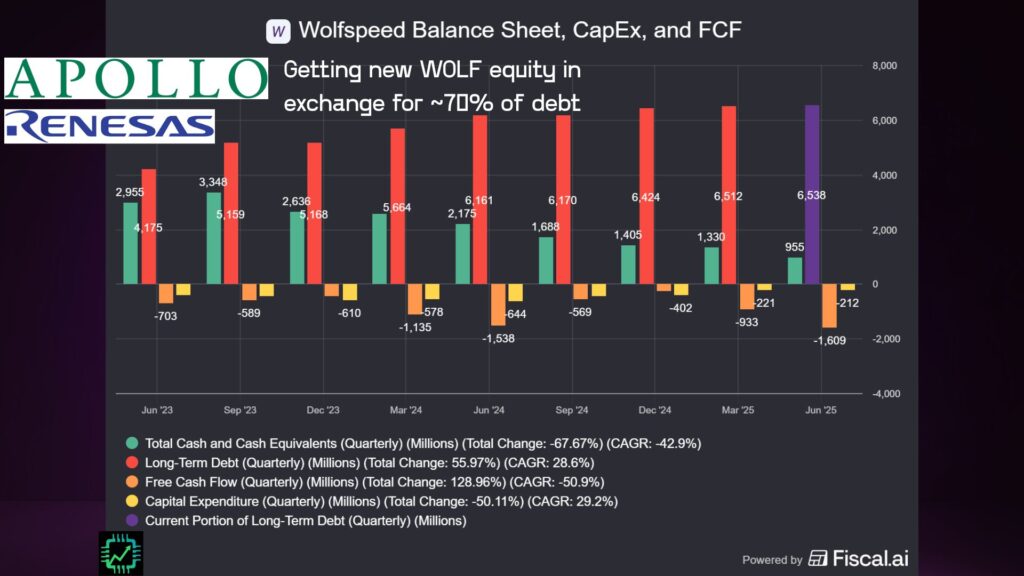
The resulting reduction in cash interest expense is ~60% (implying new debt carries a slightly higher interest rate). As of the June 2025 quarter (Q4 of Wolfspeed’s 2025 fiscal year), quarterly net interest expense was $85 million. This implies net interest payments will now be around $34 million.
What should investors do next?
If you were holding old WOLF stock, and now own new WOLF stock, it’s likely you already had a plan in place. With a new management team at Wolfspeed (including a new board of directors: https://investor.wolfspeed.com/news/news-details/2025/Wolfspeed-Appoints-Five-Experienced-Directors-to-its-Board/default.aspx), it could pay to stick to your plan and see the new course management charts for the emergent Wolfspeed.
If you don’t own WOLF stock and have been contemplating it (as we have been here at CSI, post-bankruptcy of course), there’s good reason to continue waiting for a bit more information.
The new WOLF enterprise value of some $6 billion (market cap of nearly $4 billion as of Sept. 29, plus debt of nearly $2 billion) isn’t exactly cheap. At the last quarterly financial update, Wolfspeed revenue was at an annualized run-rate of less than $800 million. The company could turn the corner on free cash flow profitability, which is an absolute ASAP must-have. But a new fiscal year has just begun at Wolfspeed, and we’ve yet to receive guidance from the new management team on the direction of revenue and profitability post-bankruptcy.
After all, bankruptcy events are disruptive in more ways than one. It’s possible some customers have headed for the exit in search of other silicon carbide (SiC) suppliers over the last few months. Wolfspeed has also been cancelling parts of its fab expansion project to reduce CapEx (see last chart above, CapEx was still over $200 million per quarter at last report). The extent of the CapEx reduction is also as-of-yet unknown, as is the impact that will have on future revenue potential. An update from management will be helpful in making a fully informed decision.
Either way, with Wolfspeed’s bankruptcy fast-track now finished and the new company still operating, view this as a high-risk and only potentially high-reward investment. We’ll continue watching with keen interest here at CSI. See you over on Semi Insider for more updates.


